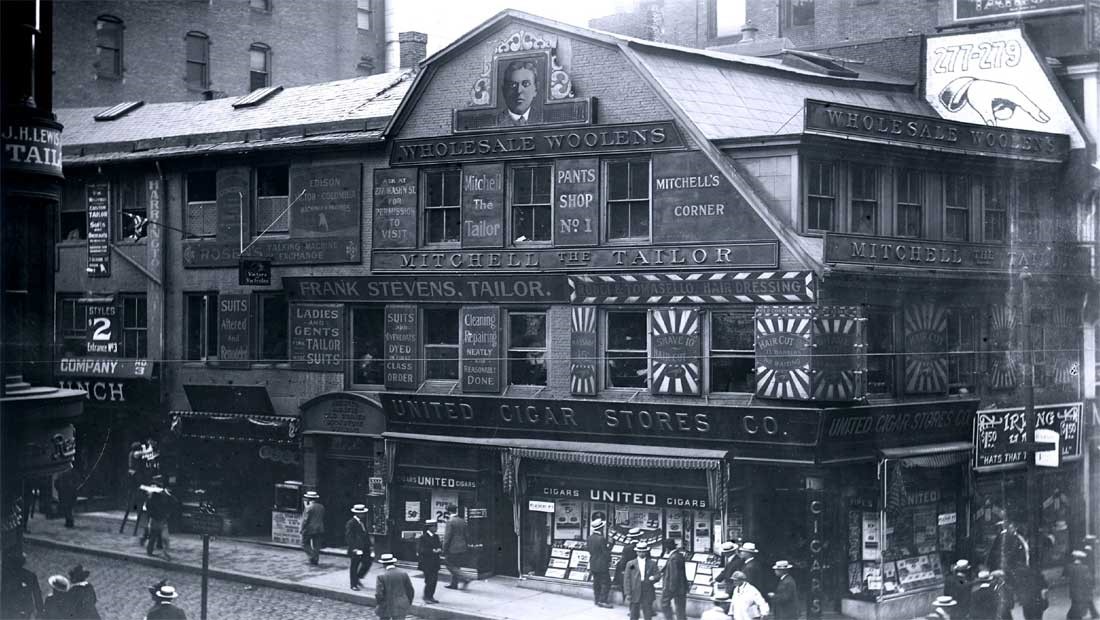
31 Aug Behind the Portrait: The Tale of Mitchell the Tailor
HBI’s Director of Real Estate Development, Tony Lopes, researched the Old Corner Bookstore’s most iconic tenant of the 20th c.
Introduction
In the heart of Boston’s Downtown Crossing, nestled at the corner of Washington and School Streets, stands a time-honored structure that has witnessed the ebb and flow of centuries. Dating back to 1718, the Old Corner Bookstore was originally the personal dwelling and apothecary shop of Dr. Thomas Crease. Over the centuries, its walls have embraced various booksellers and publishers, with Ticknor and Fields being the most renowned among them. This iconic structure has also played host to a multitude of businesses, each contributing its own chapter to the story of the Old Corner Bookstore. Among the many photographs and etchings from its storied past, one image from the early 1900s stands out. It captures the very spirit of Boston’s economic transformation, featuring a monumental portrait displayed on the side of the building during a period when the city’s population surged following a wave of immigrants. This era saw the rapid expansion of the city and a thriving downtown Boston business scene. This portrait holds the tale of William Sullivan, the man who became synonymous with commerce and dreams of achievement, known by his entrepreneurial signature, “Mitchell the Tailor.”
Humble Beginnings and the Rise of Mitchell the Tailor
Born in December of 1872, William Henry Sullivan’s life began in the bustling city of Boston. His parents, John and Anne Sullivan, were Irish immigrants who settled in South Boston, renting a modest house on Burnham Place. Sullivan started his career as a newsboy, peddling newspapers on the vibrant streets of the city, a humble occupation that fueled his enterprising spirit.
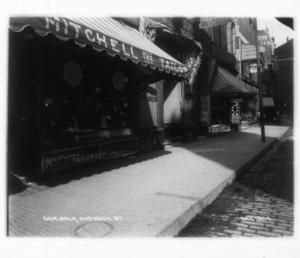
As a young man, he learned cutting and tailoring, and in 1904 at the age of 32, William took a leap of faith, purchasing the name and established business of Mitchell the Tailor, a company previously operating in Lynn, MA. October of that year, Sullivan set up a new shop at 305 Washington Street. Sullivan’s small establishment, on what was then known as Boston’s “Newspaper Row,” thrived in the bustling retail environment. Operating out of the modest shop, no wider than 14 feet by 60 feet deep, Sullivan began crafting his legacy.
Sullivan quickly made a name for himself by offering wholesale three-piece suits for the affordable price of $17.75. Drawing from his experience as a newsboy, Sullivan utilized his advertising skills to attract customers, using newspapers as his medium of choice.
By 1908, Sullivan’s success demanded a larger stage. He relocated Mitchell the Tailor a block up the street to the Old Corner Bookstore where his larger-than-life portrait adorned the building and became an iconic fixture. In the portrait, Sullivan himself showcased the concave shoulder style of suits that were in vogue at the time. This image became his trademark, gracing advertisements that reached audiences far beyond Boston’s borders.
Fashioning a Path to Success
From his new headquarters at the Old Corner Bookstore, Sullivan’s dedication to quality, affordability, and strategic advertising strategies propelled his business to new heights. The reputation of “Mitchell the Tailor from Boston” spread like wildfire, leading to the establishment of locations across New England, including Brockton, New Bedford and Springfield. His empire extended beyond state lines, with a store in Manchester, NH, Providence RI, Hartford CT, and three stores in New York City.
On June 11, 1909, Sullivan and his wife Margaret purchased a luxurious house at 334 Commonwealth Ave. A Boston Globe article dated May 29 announcing the sale indicated that “Mr. Sullivan’s intention is to raze the present structure and erect one of the finest private houses in this section of the Back Bay.” Plans prepared by C. A. & F. N. Russell architects described a house containing “15 rooms, with baths, and containing every modern improvement. It will be four stories high, of white sandstone for the front, with brick for the rear, and will cost $50,000”.
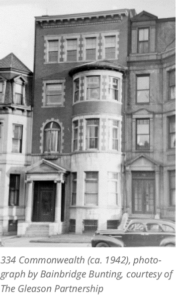
As business continued to thrive, Mr. Sullivan expanded his business holdings, with a home in Atlantic (Hull), Massachusetts, boats and several cars. His talent for effective newspaper advertising propelled his empire’s growth, and he even acquired other tailors, including the well-known Tremont Street location in Boston.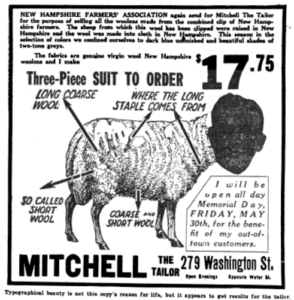
One of Sullivan’s innovative strategies was his use of a horse-drawn wagon to create mobile stores across the northeast and Midwest US region. At a cost of $2,000 per wagon, these mobile showrooms paraded through the city streets showcasing suits as salesmen give away fabric samples. Sullivan capitalized on local events to craft persuasive advertisements offering deep discounts. His commitment to success was unshakeable, even in the face of critics publicly challenging his unorthodox business practices.
According to a 1924 article published by Editor & Publisher, Mitchell the Tailor employed a sizable workforce of 400 employees across 12 stores. His empire catered to 1,500 to 2,000 buyers each week, amounting to around 80,000 customers a year.
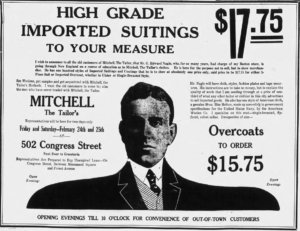
The Empire Declines
Despite Sullivan’s impressive achievements, the tide turned with the onset of the Great Depression. The stock market crash of 1929 marked the beginning of the end of Sullivan’s success. The once-thriving Mitchell the Tailor faced unprecedented difficulties.
On June 15, 1931 the luxurious house that had represented Sullivan’s success was foreclosed on by the MA Hospital Life Insurance Company, forcing the family to relocate to a more modest apartment at 180 Commonwealth Ave. William Henry Sullivan passed away on September 4, 1946, leaving behind a larger than life story, and a photograph that continues to captivate the history of the Old Corner Bookstore.
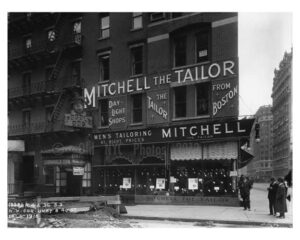
A Living Monument
The Old Corner Bookstore survives as a living monument to centuries of Boston commerce, and within its walls and facade are countless stories like that of William Henry Sullivan, a man who transformed himself from a newsboy to an empire-builder. His journey from a small tailor shop to a regional empire is a source of inspiration for Bostonians today. The portrait that once adorned the Old Corner Bookstore is a symbol of Boston’s entrepreneurial spirit and a reminder that dreams, no matter how grand, are worth pursuing.
Preserving more than just a building
In 1960, Historic Boston Incorporated (HBI) was formed to rescue the Old Corner Bookstore from the threat of demolition. HBI’s efforts not only preserve the 18th century structure, but also honor the stories and legacies of the enterprises that once occupied its walls. Today, as Chipotle and Bruegger’s Bagels occupy the space where Mitchell the Tailor once thrived, the revenue generated from these establishments support HBI’s mission of preserving all of Boston’s rich heritage and creating a unique space in which others can dream big.

Check out these HBI projects that allow today’s entrepreneurs to dream big.



